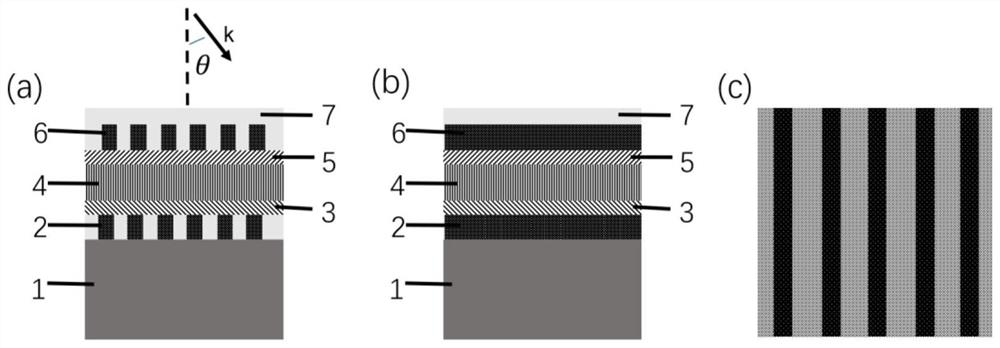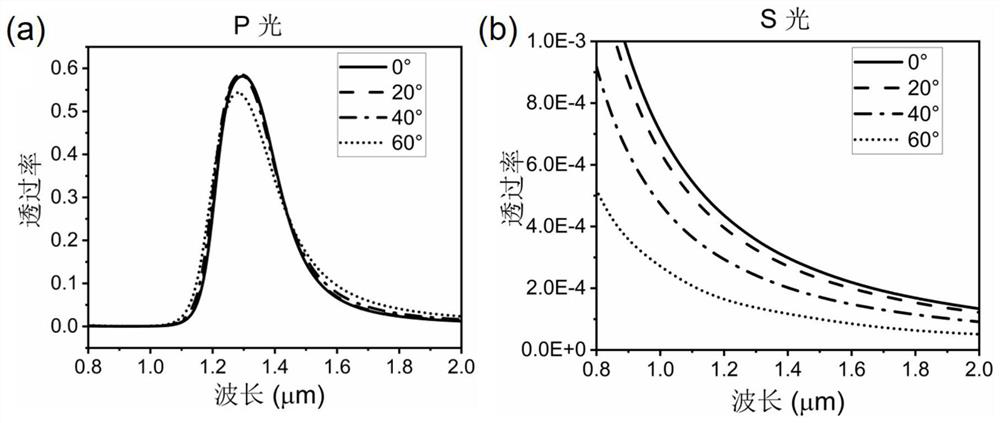Angle insensitive narrow-band filter based on double plasmon resonance
A double plasmon resonance and narrow-band filter technology, which is applied in the field of optical filters, can solve problems such as limiting the application range of narrow-band filters, narrow-band light wavelength or energy intensity changes, and achieves simple structure, fewer layers, and easy integrated effect
- Summary
- Abstract
- Description
- Claims
- Application Information
AI Technical Summary
Problems solved by technology
Method used
Image
Examples
Embodiment 1
[0030] In this example, we will demonstrate an angle-insensitive narrow-band filter based on a one-dimensional metal grating in the near-infrared band.
[0031] The structure of the narrowband filter is as figure 2 As shown, from bottom to top: substrate 1, the material selected is quartz substrate; one-dimensional Au grating 2, the period is 110nm, the thickness is 20nm, the width of silver is 89nm, and the filling medium is SiO 2 ; The dielectric isolation layer 3 is made of SiO 2 , with a thickness of 5nm; the metal layer 4 is made of Ag with a thickness of 40nm; the dielectric isolation layer 5 is made of SiO 2 , the thickness is 5nm; one-dimensional Au grating 6, the period is 110nm, the thickness is 20nm, the silver width is 90nm, and the filling medium is SiO 2 ; The protective layer 7 is made of SiO 2 , with a thickness of 10nm. Incident direction as figure 2 As shown in (a), the angle with the vertical line is θ. P light is defined as the direction of the elec...
Embodiment 2
[0034] In Embodiment 1, we demonstrate the design of an angle-insensitive filter for near-infrared. In fact, we can design angle-insensitive filters in different wavelength bands by reasonably changing the width, thickness, period and other factors of the one-dimensional grating 2 and the one-dimensional grating 6 .
[0035] In this example, we will demonstrate an angle-insensitive narrow-band filter based on a 1D metal grating in the visible band.
[0036] The structure of the narrowband filter is as figure 2 As shown in (a), from bottom to top: substrate 1, the material selected is quartz substrate; one-dimensional Au grating 2, period is 20nm, thickness is 10nm, silver width is 10nm, and the filling medium is SiO 2 ; The dielectric isolation layer 3 is made of SiO 2 , with a thickness of 10nm; the metal layer 4 is made of Ag with a thickness of 50nm; the dielectric isolation layer 5 is made of SiO 2 , the thickness is 10nm; one-dimensional Au grating 6, the period is 20...
Embodiment 3
[0039] In this example, we will demonstrate an angle-insensitive narrow-band filter based on a 1D metal grating in the mid-infrared band.
[0040] The structure of the narrowband filter is as figure 2 As shown in (a), from bottom to top: Substrate 1, the material selected is CaF 2 Substrate; one-dimensional Ag grating 2, period is 1.50 μm, thickness is 1.50 μm, silver width is 1 μm, filling medium is CaF 2 ; The dielectric isolation layer 3 is made of CaF 2 , with a thickness of 10nm; the metal layer 4 is made of Ag with a thickness of 20nm; the dielectric isolation layer 5 is made of CaF 2 , thickness is 10nm; one-dimensional Ag grating 6, period is 1.50μm, thickness is 1.50μm, silver width is 1μm, filling medium is CaF 2 ; Protective layer 7 is selected to be removed. Incident direction as figure 2 As shown in (a), the angle with the vertical line is θ. P light is defined as the direction of the electric field parallel to figure 2 (a) Light in the plane shown, S li...
PUM
| Property | Measurement | Unit |
|---|---|---|
| Width | aaaaa | aaaaa |
| Thickness | aaaaa | aaaaa |
| Thickness | aaaaa | aaaaa |
Abstract
Description
Claims
Application Information
 Login to View More
Login to View More - Generate Ideas
- Intellectual Property
- Life Sciences
- Materials
- Tech Scout
- Unparalleled Data Quality
- Higher Quality Content
- 60% Fewer Hallucinations
Browse by: Latest US Patents, China's latest patents, Technical Efficacy Thesaurus, Application Domain, Technology Topic, Popular Technical Reports.
© 2025 PatSnap. All rights reserved.Legal|Privacy policy|Modern Slavery Act Transparency Statement|Sitemap|About US| Contact US: help@patsnap.com



